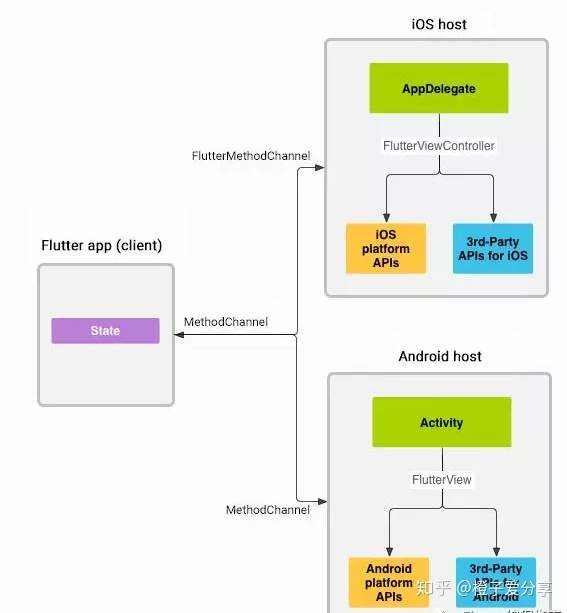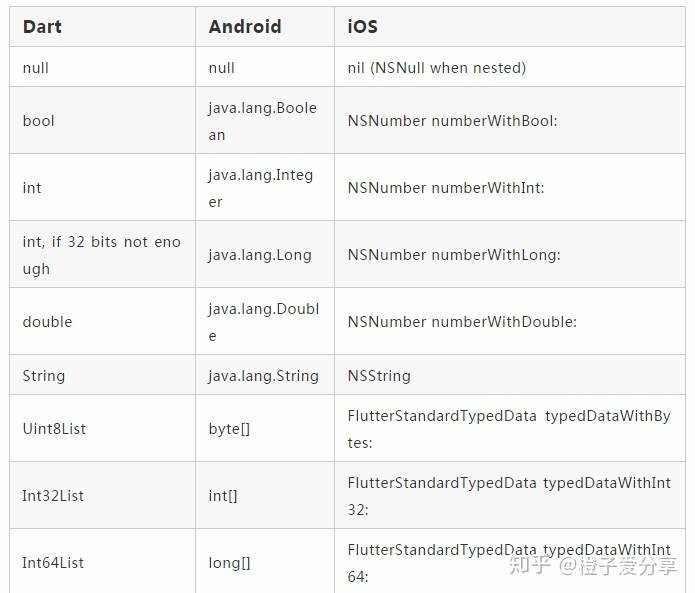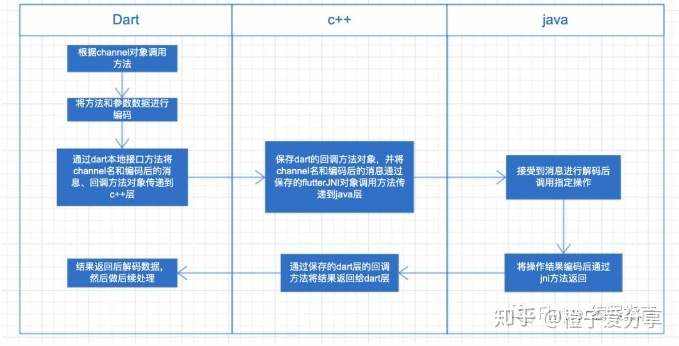
欢迎关注专栏:里面定期分享Android和Flutter架构技术知识点及解析,还会不断更新的BATJ面试专题,欢迎大家前来探讨交流,如有好的文章也欢迎投稿。
Android高级进阶zhuanlan.zhihu.com
前言
我们知道Flutter中通过Platform Channel实现Flutter和原生端的数据传递,那么这些数据是怎么传递的,传递的过程都做了哪些操作,本文将以Android为例带大家一起了解Platform Channel的工作原理。
Flutter定义了三种不同类型的Channel,分别是
本文以MethodChannel为例带大家一起进行源码分析。
MethodChannel源码解析
官方架构图

根据架构图,我们可以看出在Flutter端,MethodChannel允许发送与方法调用相对应的消息。在安卓和iOS原生端,Android上的MethodChannel和iOS上的FlutterMethodChannel启用接收方法调用并发回结果给Flutter端。而这种数据传递方式还可以反向调用。为了保证用户界面保持相应而不卡顿,消息和响应以异步的形式进行传递。
下面根据官方提供的demo一步一步来进行分析其具体实现。官方提供的demo代码地址如下,实现了一个从Flutter端发起的方法调用,从原生端获取电量并返回给Flutter端用于展示。
Writing custom platform-specific code
先来看一下Flutter中dart相关的代码
static const platform = const MethodChannel('samples.flutter.io/battery');Future
Dart层方法调用的消息传递分析
首先,dart中会先创建一个MethodChannel对象,其名称为“samples.flutter.io/battery”,这个名字很关键,必须与原生端的名字相对应,具体原因后边会有解释。通过异步方式调用invokeMethod方法传入方法名来获取电量信息platform.invokeMethod('getBatteryLevel');,invokeMethod方法具体实现如下
../engine/shell/platform/android/io/flutter/plugin/common/MethodChannel.java
@optionalTypeArgsFuture
通过BinaryMessages.send()方法来发送方法调用消息,我们可以看到send方法有两个参数,第一个是channel的名称,第二个是ByteData对象(使用codec对根据方法名和参数构建的MethodCall对象进行编码得到的对象);codec对象是在MethodChannel对象创建时默认创建的StandardMethodCodec对象,其对MethodCall对象的编码过程如下
../engine/shell/platform/android/io/flutter/plugin/common/StandardMethodCodec.java
@override
ByteData encodeMethodCall(MethodCall call) {final WriteBuffer buffer = WriteBuffer();messageCodec.writeValue(buffer, call.method);messageCodec.writeValue(buffer, call.arguments);return buffer.done();
}
通过messageCodec将调用的方法名和传递的参数写入到buffer中,messageCodec是一个StandardMessageCodec对象,在StandardMethodCodec对象创建时默认创建,其writeValue方法的实现如下
../engine/shell/platform/android/io/flutter/plugin/common/StandardMessageCodec.java
void writeValue(WriteBuffer buffer, dynamic value) {if (value &#61;&#61; null) {buffer.putUint8(_valueNull);} else if (value is bool) {buffer.putUint8(value ? _valueTrue : _valueFalse);} else if (value is int) {if (-0x7fffffff - 1 <&#61; value && value <&#61; 0x7fffffff) {buffer.putUint8(_valueInt32);buffer.putInt32(value);} else {buffer.putUint8(_valueInt64);buffer.putInt64(value);}} else if (value is double) {buffer.putUint8(_valueFloat64);buffer.putFloat64(value);} else if (value is String) {buffer.putUint8(_valueString);final List
从上述代码看出&#xff0c;Flutter与平台端的消息传递支持12种类型&#xff0c;这12种类型分别与安卓和iOS中的类型相对应&#xff0c;看下面表格更直观


writeValue方法其实就是将方法名和参数转化为对应的二进制数据写入buffer中&#xff0c;方法名都是String类型&#xff0c;我们就以String类型方法写入过程来进行简单说明&#xff0c;如果判断一个value为String后&#xff0c;
1、调用buffer.putUint8(_valueString);先写入对应的类型值&#xff0c;_valueString &#61; 7;&#xff0c;所以将00000111二进制数据写入buffer&#xff1b;
2、紧接着将value通过utf8编码为int数组&#xff0c;然后将数组的长度数据通过writeSize(buffer, bytes.length);写入buffer&#xff1b;
3、最后再将数组数据写入buffer&#xff0c;至此一个方法名编码完成&#xff1b;
其他类型的数据依次类推进行编码&#xff0c;编码完成后&#xff0c;将StandardMessageCodec对象编码的ByteData数据通过BinaryMessages.send()方法发送出去&#xff0c;看下send方法的具体实现
../flutter/packages/flutter/lib/src/services/platform_messages.dart
static Future
}
会从_mockHandlers中查找是否缓存的有_MessageHandler对象&#xff0c;如果没有则通过_sendPlatformMessage方法发送消息&#xff0c;
../flutter/packages/flutter/lib/src/services/platform_messages.dart
static Future
其最终调用的是ui.window.sendPlatformMessage方法&#xff0c;该方法中会传递回调方法对象&#xff0c;在数据返回后会被回调从而得到结果数据。
../engine/lib/ui/window.dart
void sendPlatformMessage(String name,ByteData data,PlatformMessageResponseCallback callback) {final String error &#61;_sendPlatformMessage(name, _zonedPlatformMessageResponseCallback(callback), data);if (error !&#61; null)throw new Exception(error);}String _sendPlatformMessage(String name,PlatformMessageResponseCallback callback,ByteData data) native &#39;Window_sendPlatformMessage&#39;;
在以上代码中ui.window.sendPlatformMessage()方法最终会调用Dart本地接口方法_sendPlatformMessage&#xff0c;这里可以将这个方法简单理解为类似于java的JNI的方法&#xff0c;在c&#43;&#43;层会调用"Window_sendPlatformMessage"对应的方法。至此&#xff0c;dart中的方法消息传递已经结束&#xff0c;我们下面开始从Flutter engine源码中分析c&#43;&#43;层是如何对方法调用消息进行传递的。
c&#43;&#43;层消息的传递流程分析
我们在engine源码文件的./lib/ui/window/http://window.cc文件中找到了关于dart本地方法的注册代码块
../engine/lib/ui/window/http://window.cc
void Window::RegisterNatives(tonic::DartLibraryNatives* natives) {natives->Register({{"Window_defaultRouteName", DefaultRouteName, 1, true},{"Window_scheduleFrame", ScheduleFrame, 1, true},{"Window_sendPlatformMessage", _SendPlatformMessage, 4, true},{"Window_respondToPlatformMessage", _RespondToPlatformMessage, 3, true},{"Window_render", Render, 2, true},{"Window_updateSemantics", UpdateSemantics, 2, true},{"Window_setIsolateDebugName", SetIsolateDebugName, 2, true},});
}
通过代码可以看到通过tonic::DartLibraryNatives的对象指针调用Register()方法对window对应的多个dart本地方法进行了注册&#xff08;说明&#xff1a;该注册方法的调用是在flutter引擎初始化后Dart虚拟机初始化时调用&#xff0c;这里不再对这一块进行分析&#xff0c;知道即可&#xff09;。其中就有上面提到的“Window_sendPlatformMessage”&#xff0c;该符号对应到的c&#43;&#43;方法为_SendPlatformMessage&#xff0c;我们看下该方法中做了些什么&#xff0c;
../engine/lib/ui/window/http://window.cc
void _SendPlatformMessage(Dart_NativeArguments args) {tonic::DartCallStatic(&SendPlatformMessage, args);
}Dart_Handle SendPlatformMessage(Dart_Handle window,const std::string& name,Dart_Handle callback,const tonic::DartByteData& data) {UIDartState* dart_state &#61; UIDartState::Current();...fml::RefPtr
}
dart_state是一个UIDartState对象指针&#xff0c;指向当前线程&#xff08;UI thread&#xff09;对应的isolate对象Root isolate&#xff0c;回调对象callback不为null&#xff0c;则会根据dart_state和callback创建一个tonic::DartPersistentValue对象&#xff0c;然后根据当前线程的ui task runner创建一个平台消息响应对象response(该response会在消息响应结果返回时使用到)&#xff0c;接下来走到代码中注释下面的代码块&#xff0c;其dart_state->window()->client()返回的是Engine对象创建时创建的RuntimeController对象(这个也要回溯到引擎和DartVM初始化的过程&#xff0c;这里不再展开&#xff0c;知道即可)&#xff0c;下面会调用该对象的HandlePlatformMessage()方法&#xff0c;方法中传递的是包含有channel名、方法调用的相关数据和response对象(fml::RefPtr对象&#xff0c;消息响应返回后会使用到)的fml::RefPtr
../engine/runtime/http://runtime_controller.cc
void RuntimeController::HandlePlatformMessage(fml::RefPtr
}
接着调用client_的HandlePlatformMessage()方法&#xff0c;client_是一个继承了RuntimeDelegate类的Engine对象&#xff0c;
../engine/shell/common/http://engine.cc
void Engine::HandlePlatformMessage(fml::RefPtr
}
由最开始的demo可知channel是我们自定义的名称为“samples.flutter.io/battery”的channel&#xff0c;所以会执行else中的代码块&#xff0c;这里的delegate_是指继承了Engine::Delegate类的Shell对象&#xff0c;
../engine/shell/common/http://shell.cc
// |shell::Engine::Delegate|
void Shell::OnEngineHandlePlatformMessage(fml::RefPtr
}
由于Engine的创建是在UI task Runner中即UI thread中创建&#xff0c;所以以上所有消息传递都是在UI thread中进行&#xff0c;由于平台相关的api都是运行在主线程&#xff0c;马上要将消息发送给平台&#xff0c;所以此处会将消息交由platform task Runner执行&#xff0c;即在platform thread中执行方法调用。platform_view_是一个继承了PlatformView类的PlatformViewAndroid对象&#xff0c;该对象在创建AndroidShellHolder对象时被创建。view->HandlePlatformMessage执行以下方法&#xff0c;
../engine/shell/platform/android/http://platform_view_android.cc
// |shell::PlatformView|
void PlatformViewAndroid::HandlePlatformMessage(fml::RefPtr
}
消息响应对象response不为空时&#xff0c;创建一个response_id并将其对应response保存到pending_responses_中&#xff08;消息响应结果返回后会根据response_id取出response对象来处理响应结果&#xff09;&#xff0c;消息数据不为空时调用if代码块中的代码&#xff0c;然后会调用http://platform_view_android_jni.cc中的以下方法&#xff0c;view.obj()为java中的flutterJNI对象&#xff0c;这个对象是在AndroidShellHolder对象创建时从java层传递过来的。最后通过env->CallVoidMethod()方法调用java层的flutterJNI对象的handlePlatformMessage方法&#xff0c;将channel名称、消息内容和响应ID传给java层。
../engine/shell/platform/android/http://platform_view_android_jni.cc
static jmethodID g_handle_platform_message_method &#61; nullptr;
void FlutterViewHandlePlatformMessage(JNIEnv* env,jobject obj,jstring channel,jobject message,jint responseId) {env->CallVoidMethod(obj, g_handle_platform_message_method, channel, message,responseId);FML_CHECK(CheckException(env));
}
接下来我们开始分析java层接受到消息后的处理逻辑。
java层接受消息后的处理流程分析
通过以上分析&#xff0c;c&#43;&#43;层通过调用flutterJNI的handlePlatformMessage方法将消息传递给java层&#xff0c;我们来看一下FlutterJNI中的方法实现
../engine/shell/platform/android/io/flutter/embedding/engine/FlutterJNI.java
private void handlePlatformMessage(String channel, byte[] message, int replyId) {if (this.platformMessageHandler !&#61; null) {this.platformMessageHandler.handleMessageFromDart(channel, message, replyId);}
}
此时会调用platformMessageHandler的handleMessageFromDart()方法&#xff0c;platformMessageHandler对象是在FlutterNativeView构造方法中创建FlutterJNI对象后设置进来的&#xff0c;是一个实现了PlatformMessageHandler接口的FlutterNativeView.PlatformMessageHandlerImpl对象&#xff0c;我们看一下它的handleMessageFromDart()方法实现
../engine/shell/platform/android/io/flutter/view/FlutterNativeView.java
public void handleMessageFromDart(final String channel, byte[] message, final int replyId) {FlutterNativeView.this.assertAttached();BinaryMessageHandler handler &#61; (BinaryMessageHandler)FlutterNativeView.this.mMessageHandlers.get(channel);if (handler !&#61; null) {try {ByteBuffer buffer &#61; message &#61;&#61; null ? null : ByteBuffer.wrap(message);handler.onMessage(buffer, new BinaryReply() {private final AtomicBoolean done &#61; new AtomicBoolean(false);public void reply(ByteBuffer reply) {if (!FlutterNativeView.this.isAttached()) {Log.d("FlutterNativeView", "handleMessageFromDart replying ot a detached view, channel&#61;" &#43; channel);} else if (this.done.getAndSet(true)) {throw new IllegalStateException("Reply already submitted");} else {if (reply &#61;&#61; null) {FlutterNativeView.this.mFlutterJNI.invokePlatformMessageEmptyResponseCallback(replyId);} else {FlutterNativeView.this.mFlutterJNI.invokePlatformMessageResponseCallback(replyId, reply, reply.position());}}}});} catch (Exception var6) {Log.e("FlutterNativeView", "Uncaught exception in binary message listener", var6);FlutterNativeView.this.mFlutterJNI.invokePlatformMessageEmptyResponseCallback(replyId);}} else {FlutterNativeView.this.mFlutterJNI.invokePlatformMessageEmptyResponseCallback(replyId);}
}
首先根据channel名称从mMessageHandlers中查找对应的BinaryMessageHandler对象&#xff0c;如果找到则执行该对象的onMessage()方法&#xff0c;那么mMessageHandlers中是怎么保存我们的channel名称为“samples.flutter.io/battery”的对象的呢&#xff0c;我们看下开始所说的demo中的java模块相关代码&#xff0c;
private static final String CHANNEL &#61; "samples.flutter.io/battery";new MethodChannel(getFlutterView(), CHANNEL).setMethodCallHandler(new MethodChannel.MethodCallHandler() {&#64;Overridepublic void onMethodCall(MethodCall call, MethodChannel.Result result) {if (call.method.equals("getBatteryLevel")) {int batteryLevel &#61; getBatteryLevel();if (batteryLevel !&#61; -1) {result.success(batteryLevel);} else {result.error("UNAVAILABLE", "Battery level not available.", null);}} else {result.notImplemented();}}});
这块代码在MainActivity中的onCreate方法中&#xff0c;创建一个名为“samples.flutter.io/battery”的MethodChannel对象&#xff0c;然后设置对应的MethodCallHandler对象&#xff0c;setMethodCallHandler的方法实现如下
../engine/shell/platform/android/io/flutter/plugin/common/MethodChannel.java
public void setMethodCallHandler(&#64;Nullable MethodChannel.MethodCallHandler handler) {this.messenger.setMessageHandler(this.name, handler &#61;&#61; null ? null : new MethodChannel.IncomingMethodCallHandler(handler));
}
其中的messenger就是通过getFlutterView()获取到的实现了BinaryMessenger接口的FlutterView对象&#xff0c;方法的第二个参数是通过handler对象包装的MethodChannel.IncomingMethodCallHandler对象&#xff0c;看下FlutterView中对接口方法setMessageHandler()的实现../engine/shell/platform/android/io/flutter/view/FlutterView.java
public void setMessageHandler(String channel, BinaryMessageHandler handler) {this.mNativeView.setMessageHandler(channel, handler);
}
会调用对应的FlutterNativeView的setMessageHandler()方法&#xff0c;FlutterNativeView同样实现了BinaryMessenger接口&#xff0c;看下其中的方法实现../engine/shell/platform/android/io/flutter/view/FlutterNativeView.java
public void setMessageHandler(String channel, BinaryMessageHandler handler) {if (handler &#61;&#61; null) {this.mMessageHandlers.remove(channel);} else {this.mMessageHandlers.put(channel, handler);}
}
到此&#xff0c;我们发现在MainActivity的onCreate方法中实现的MethodCallHandler通过一系列操作被包装到IncomingMethodCallHandler对象中并设置进了mMessageHandlers中。那么我们上面所说的onMessage方法的调用即是IncomingMethodCallHandler对象的方法&#xff0c;
../engine/shell/platform/android/io/flutter/plugin/common/MethodChannel.java
public void onMessage(ByteBuffer message, final BinaryReply reply) {MethodCall call &#61; MethodChannel.this.codec.decodeMethodCall(message);try {this.handler.onMethodCall(call, new MethodChannel.Result() {public void success(Object result) {reply.reply(MethodChannel.this.codec.encodeSuccessEnvelope(result));}public void error(String errorCode, String errorMessage, Object errorDetails) {reply.reply(MethodChannel.this.codec.encodeErrorEnvelope(errorCode, errorMessage, errorDetails));}public void notImplemented() {reply.reply((ByteBuffer)null);}});} catch (RuntimeException var5) {Log.e("MethodChannel#" &#43; MethodChannel.this.name, "Failed to handle method call", var5);reply.reply(MethodChannel.this.codec.encodeErrorEnvelope("error", var5.getMessage(), (Object)null));}}
方法中首先将从c&#43;&#43;层传递过来的消息通过codec解码为MethodCall对象&#xff0c;然后调用MainActivity中实现的MethodHandler的onMethodCall方法&#xff0c;改方法实现中会获取当前手机电量信息int batteryLevel &#61; getBatteryLevel();&#xff0c;然后调用result.success()方法&#xff0c;通过reply.reply(MethodChannel.this.codec.encodeSuccessEnvelope(result));将结果数据编码后进行返回。reply方法中会调用FlutterNativeView.this.mFlutterJNI.invokePlatformMessageResponseCallback(replyId, reply, reply.position());方法将响应结果返回&#xff0c;方法具体实现如下
../engine/shell/platform/android/io/flutter/embedding/engine/FlutterJNI.java
&#64;UiThread
public void invokePlatformMessageResponseCallback(int responseId, ByteBuffer message, int position) {this.ensureAttachedToNative();this.nativeInvokePlatformMessageResponseCallback(this.nativePlatformViewId, responseId, message, position);
}private native void nativeInvokePlatformMessageResponseCallback(long var1, int var3, ByteBuffer var4, int var5);
最终会调用JNI方法将数据返回给c&#43;&#43;层&#xff0c;下面我们再接着看c&#43;&#43;层中接受到响应数据后的处理逻辑。
c&#43;&#43;层接收消息响应后的处理流程分析
根据JNI方法动态注册模块可知&#xff0c;nativeInvokePlatformMessageResponseCallback方法对应以下c&#43;&#43;方法&#xff0c;
../engine/shell/platform/android/http://platform_view_android_jni.cc
static void InvokePlatformMessageResponseCallback(JNIEnv* env,jobject jcaller,jlong shell_holder,jint responseId,jobject message,jint position) {ANDROID_SHELL_HOLDER->GetPlatformView()->InvokePlatformMessageResponseCallback(env, //responseId, //message, //position //);
}
接着会调用AndroidShellHolder对象持有的PlatformViewAndroid对象的InvokePlatformMessageResponseCallback方法&#xff0c;
../engine/shell/platform/android/http://platform_view_android.cc
void PlatformViewAndroid::InvokePlatformMessageResponseCallback(JNIEnv* env,jint response_id,jobject java_response_data,jint java_response_position) {if (!response_id)return;auto it &#61; pending_responses_.find(response_id);if (it &#61;&#61; pending_responses_.end())return;uint8_t* response_data &#61;static_cast
}
根据response_id从pending_responses_中查找对应的message_response对象&#xff0c;通过对象指针调用其Complete方法处理响应结果&#xff0c;根据以上过程中代码的分析可知该方法对应的是继承了PlatformMessageResponse类的PlatformMessageResponseDart类对象的Complete方法&#xff0c;
../engine/lib/ui/window/http://platform_message_response_dart.cc
void PlatformMessageResponseDart::Complete(std::unique_ptr
}
这里会将返回的数据处理通过uitaskrunner执行&#xff0c;即会在UI thread中执行。callback即为上面分析的dart中对应的回调方法PlatformMessageResponseCallback的对象&#xff0c;通过tonic::DartInvoke()方法将消息返回结果传递到dart层进行处理。
Dart层接收消息响应后的处理流程分析
通过以上Dart层传递消息分析可知PlatformMessageResponseCallback方法回调后对byte_buffer数据进行处理&#xff0c;通过completer.complete()方法完成返回数据&#xff0c;然后一步步返回到调用方法层&#xff0c;在异步方法中通过await等待数据返回后&#xff0c;再通过setState改变State中的变量值从而刷新页面数据将电量信息显示到屏幕上。至此&#xff0c;整个flutter发消息给platform并接收消息处理的流程就完成了。
总结
先上一张消息传递流程图

通过整个源码流程的跟踪&#xff0c;整个消息发送和接收结果的流程分为以下几步&#xff1a;
转自&#xff1a;全面解析Flutter Platform Channel原理

 京公网安备 11010802041100号 | 京ICP备19059560号-4 | PHP1.CN 第一PHP社区 版权所有
京公网安备 11010802041100号 | 京ICP备19059560号-4 | PHP1.CN 第一PHP社区 版权所有